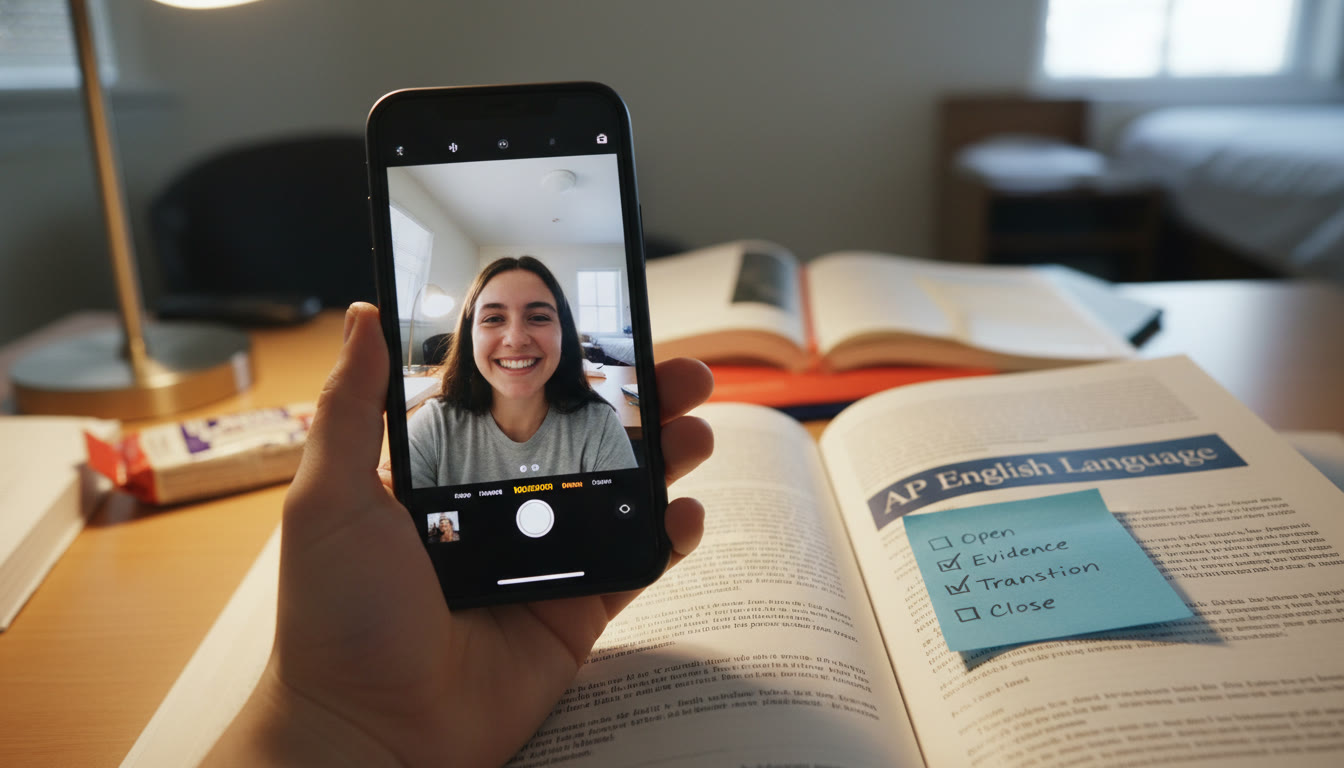Why Speaking Clinics Matter: From Nervous Mumbles to Confident Cohesion
Imagine you’re three minutes into an AP oral response: your mind races, your voice wobbles, and your answer starts to drift. The ideas are there, but they don’t feel linked; you circle around a point without landing on it. That gap between what you know and what you clearly communicate is where cohesion and circumlocution live—and where a well-designed speaking clinic can change everything.

In the context of AP exams and AP-style oral assessments, cohesion is the glue that binds your thoughts—logical connectors, clear transitions, and a visible structure. Circumlocution, on the other hand, is the strategic detour you take when the exact word or phrase escapes you: it’s the graceful way to describe, exemplify, or paraphrase without losing momentum. When practiced together, they turn halting responses into persuasive, exam-ready speech.
Who Benefits from Speaking Clinics?
Speaking clinics help a wide range of students:
- Students preparing for AP oral components (languages, presentations, or free-response explanations).
- Learners who know content but struggle to express it succinctly under time pressure.
- Students developing academic voice and formal register for exams.
- Those aiming to improve pronunciation, pacing, and rhetorical clarity.
Core Concepts: Cohesion and Circumlocution Explained
Cohesion: Building Logical Bridges
Cohesion is about making the path through your argument or explanation unmistakable for the listener. The hallmark characteristics are:
- Clear opening statements that preview your main idea.
- Pronounced transitions that signal relationships (cause/effect, contrast, example).
- Consistent reference chains (pronouns and nouns that clearly point back to earlier ideas).
- Concise summaries and signposts that guide the listener to your conclusion.
Circumlocution: Elegance When Words Fail
Circumlocution isn’t a sign of weakness; it’s a demonstration of linguistic resourcefulness. Instead of freezing when you can’t recall a precise term, circumlocution lets you keep communicating with clarity. Techniques include:
- Using synonyms and near-synonyms.
- Describing function, shape, or effect (“the device that measures temperature” instead of “thermometer”).
- Giving quick examples or analogies to illustrate meaning.
- Rephrasing the sentence so the missing word is no longer necessary.
Structure of an Effective Speaking Clinic
A speaking clinic is a focused, repeatable routine students can use weekly. Here’s a compact structure that fits seamlessly into class time or a tutoring session:
- Warm-up (3–5 minutes) — quick tongue twisters, breath control, or a 30-second elevator pitch.
- Modeling (5–7 minutes) — instructor demonstrates a high-quality response, highlighting cohesion markers and circumlocution in real time.
- Practice Rounds (15–20 minutes) — students respond to prompts in timed rounds (1–3 minutes), followed by peer and tutor feedback.
- Targeted Drills (10 minutes) — focus on transitions, signposting, or circumlocution phrases.
- Reflection & Action Plan (5 minutes) — each student records one concrete goal for the next clinic.
Clinic Activities: From Micro-Tasks to Full Responses
Activity 1 — The One-Sentence Anchor
Goal: Force clarity of purpose. Students must summarize their answer to a prompt in one sentence. Then expand into a cohesive two- to three-sentence explanation that uses at least two explicit transition words (e.g., however, therefore, moreover).
Activity 2 — Circumlocution Relay
Goal: Build agility when vocabulary slips. One student begins describing a concept without naming it. The next student must paraphrase the description and add a new detail. This chain continues for three passes, encouraging creative synonyms and example-driven definitions.
Activity 3 — Transition Swap
Goal: Make transitions audible. Give students a paragraph-length explanation. Ask them to read it aloud but replace all transitions with others (e.g., replace “because” with “as a result” or “nevertheless” with “on the other hand”) and observe how meaning or emphasis shifts.
Activity 4 — Timed Full-Response Simulation
Goal: Combine cohesion and circumlocution under pressure. Use AP-style prompts (e.g., analyze a rhetorical choice, explain a scientific concept, or argue a historical interpretation). Students get 60–90 seconds to plan and 90–180 seconds to speak. Record responses for review.
Practical Phrases and Sentence Frames
One of the biggest barriers to fluent speaking is not having a go-to phrase bank. Memorize and practice these short frames so they become automatic during a response.
- Opening: “In short, my claim is that…”
- Signposting: “First, I will explain… Next, I will consider… Finally…”
- Linking Evidence: “For example, this shows…”
- Contrast: “However, it is important to note…”
- Clarifying: “What I mean by this is…”
- Circumlocution Starter: “It’s a kind of [category] that…”
- Temporizing (buy thinking time): “That’s a great question. To put it another way…”
Sample Clinic Prompts and Model Responses
Below are three AP-style prompts with compact model responses that highlight cohesion and circumlocution. Use these in practice rounds and record students for self-review.
| Prompt | Model Response (Key Cohesion/Circumlocution Features) |
|---|---|
| Explain how metaphor shapes a text’s argument. | “Metaphor clarifies abstract ideas by linking them to familiar images. For instance, when the author calls the economy a ‘delicate clock,’ she signals fragility and precision—therefore we read the subsequent policy suggestions as careful, incremental fixes rather than radical change. In short, the metaphor functions as a lens that focuses reader attention. If you don’t recall the exact term for ‘small-scale adjustments,’ you can describe them as ‘gradual measures intended to keep the system running smoothly.’” |
| Describe how photosynthesis supports life on Earth. | “Photosynthesis converts light energy into chemical energy, which organisms use as fuel. First, plants absorb sunlight and use it to build sugars—so, in effect, the sun becomes stored food. As a result, animals eating plants or plant-eating animals tap into that stored energy. Put another way, photosynthesis is the baseline process that channels solar energy into the food web—it’s like a primary power station for ecosystems.” |
| Argue whether technological progress always equates to social progress. | “Technological progress does not automatically translate to social progress. While innovations can expand access or efficiency, there are often unintended consequences—inequality, environmental costs, or the erosion of privacy. For example, the internet improved information sharing, but it also amplified misinformation. Therefore, we must evaluate progress using social metrics, not just technological ones. If I can’t recall a specific policy term, I’d describe it as ‘measures that govern long-term equity and sustainability.'” |
How to Give Feedback in Clinics
Feedback should be fast, specific, and actionable. Use a three-part method:
- Praise — name one clear strength (“Strong opening sentence”).
- Polish — give one concrete suggestion (“Add a brief signpost before your example”).
- Practice — assign a micro-drill (“Next time, use two circumlocution strategies when you can’t find a term”).
Keeping feedback short prevents cognitive overload and models the kind of concise revisions students can make quickly under exam conditions.
Tracking Progress: Simple Metrics That Work
Quantifying spoken improvement is tricky, but these lightweight measures give tangible evidence of growth.
| Metric | What to Track | Target |
|---|---|---|
| Response Structure | Presence of opening, two body points, and conclusion | 4/5 sessions show full structure |
| Use of Transitions | Number of cohesive markers per response | At least 3 clear markers |
| Circumlocution Attempts | Instances where student successfully paraphrases missing term | Successful in 80% of attempts |
| Fluency | Percent of uninterrupted speaking time vs. pauses | Increase uninterrupted percentage by 10–15% |
Common Pitfalls and How to Avoid Them
- Over-reliance on filler words (“um,” “like”). Replace with short, intentional breath beats or templated phrases like “Let me reframe that.”
- Overcomplicating language to sound formal. Precision beats pomp: choose clarity over flashy vocabulary.
- Neglecting the listener. Always ask: “Can a listener follow this without seeing my notes?” If not, add a clearer signpost or example.
- Rushing. Faster speaking increases errors; practice pacing by timing and deliberately pausing at signposts.
Integrating Technology and Personalized Support
Recording practice responses and reviewing them with time-stamped notes is one of the fastest ways to improve. Pair that with targeted coaching—where a tutor reviews recordings and gives tailored strategies—and progress accelerates. This is where personalized tutoring services, such as Sparkl’s personalized tutoring, naturally fit. A one-on-one tutor can craft tailored study plans, offer AI-driven insights from your recorded sessions, and provide focused practice on cohesion or circumlocution, adapting to your exact weaknesses and strengths.
Designing a 6-Week Speaking Clinic Plan
This sample plan assumes one 30–45 minute clinic per week and builds both skill and confidence.
- Week 1: Foundations — introductions, one-sentence anchors, and basic transitions.
- Week 2: Circumlocution — drills for paraphrase, example-based definitions, and the circumlocution relay.
- Week 3: Integration — timed full-response practice and targeted feedback on cohesion.
- Week 4: Register and Rhetoric — adjusting tone for AP prompts and practicing persuasive signposting.
- Week 5: Advanced Strategies — combining circumlocution with rhetorical moves and visual description when needed.
- Week 6: Mock Exam Clinic — full-length simulations, recording, and an individualized action plan for continued improvement.
Real-World Context: Why These Skills Matter Beyond AP
Cohesion and circumlocution aren’t just exam hacks — they are life skills. Clear oral communication matters in interviews, lab presentations, courtroom testimony, and collaborative projects. Students who master the ability to keep speaking, clarify, and redirect build a professional edge: they sound prepared, thoughtful, and adaptable.
Quick Reference Cheat Sheet (Printable)
Here’s a short actionable cheat sheet students can memorize.
- Start: State your claim in one sentence.
- Structure: Use “First… Next… Finally…” as signposts.
- Support: Give a quick example or statistic to anchor abstract points.
- Circumlocute: If the right word is missing, describe it functionally and move on.
- Close: End with a one-sentence conclusion that ties back to your opening.

How Tutors and Clinics Should Collaborate
Tutors amplify what clinics introduce. While clinics provide routine, peer feedback, and repetition, one-on-one tutors offer diagnosis and customization. A proficient tutor will:
- Listen to recorded responses and identify recurring cohesion gaps.
- Create micro-drills targeting an individual’s circumlocution weaknesses.
- Use data from clinics to personalize pacing and focus areas—something Sparkl’s personalized tutoring emphasizes with tailored study plans and expert tutor matching.
Final Thoughts: Practice with Purpose
Speaking clinics are not passive drills; they are labs for deliberate practice. Treat each clinic as a chance to test a single hypothesis about your speech—try a new transition, a different opening line, or an alternate circumlocution strategy. Record, listen, and iterate. Over time, your responses become more tightly woven, more flexible, and more exam-ready.
Remember: cohesion helps your listener follow you; circumlocution keeps the conversation moving. Combined, they give you the power to communicate knowledge confidently under pressure. If you pair clinic routines with personalized guidance—targeted feedback and tailored practice plans—you’ll notice faster, more durable gains. And whether you work with a teacher, a peer group, or a personalized tutoring service, the habits you build in these clinics will carry you well beyond the AP classroom.
Actionable Next Steps
Start small and be consistent. For this week:
- Run a 10-minute self-clinic: one warm-up, two one-minute responses to AP prompts, and one 2-minute recording review.
- Pick three phrase frames from this article and use them in every response.
- Schedule one 1-on-1 review session if possible; bring your recordings and a short list of questions.
Speak clearly, plan briefly, and keep moving. That’s how confident, cohesive responses are born.


















No Comments
Leave a comment Cancel